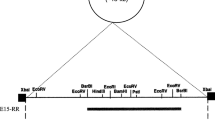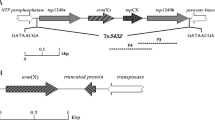Abstract
An isolate from the fecal samples of children was identified as Bifidobacterium longum. A plasmid isolated from it pBIFA24 was 4,892 bp with three open reading frames, ORFI, ORFII, and ORFIII. ORFI encoded a replication protein involved in a rolling-circle replication mechanism, and three sets of tandem repeat sequences featuring iteron structure were identified. Secondary structure prediction analysis of ORFII suggested it was a transmembrane protein. ORFIII showed high amino acid sequence identity with some mobilization proteins and contained an oriT sequence.





Similar content being viewed by others
References
Anderson DG, Mckay LL (1983) Simple and rapid method for isolating large plasmid DNA from lactic Streptococci. Appl Environ Microbiol 45:549–552
Argnani A, Leer RJ, van Luijk N, Pouwels PH (1996) A convenient and reproducible method to genetically transform bacteria of the genus Bifidobacterium. Microbiology 142:109–114
Bourget N, Simonet JM, Decaris B (1993) Analysis of the genome of five Bifidobacterium breve strains: plasmid content, pulsed-field gel electrophoresis genome size estimation and rrn loci number. FEMS Microbiol Lett 110:11–20
Burns AJ, Rowland IR (2004) Antigenotoxicity of probiotics and prebiotics on faecal water-induced DNA damage in human colon adenocarcinoma cells. Mutat Res Fund Mol Mech Mutagen 551:233–243
Caspi R, Pacek M, Consiglieri G, Helinski DR, Toukdarian A, Konieczny I (2001) A broad host range replicon with different requirements for replication initiation in three bacterial species. EMBO J 12:3262–3271
Corneau N, Emond E, LaPointe G (2004) Molecular characterization of three plasmids from Bifidobacterium longum. Plasmid 51:87–100
Del Solar G, Giraldo R, Ruiz-Echevarria MJ, Espinosa M, Diaz-Orejas R (1998) Replication and control of circular bacterial plasmids. Microbiol Mol Biol Rev 62:434–464
Dempsey LA, Birch P, Khan SA (1992a) Six amino acids determine the sequence-specific DNA binding and replication specificity of the initiator proteins of the pT181 family. J Biol Chem 267:24538–24543
Dempsey LA, Birch P, Khan SA (1992b) Uncoupling of the DNA topoisomerase and replication activities of an initiator protein. Proc Natl Acad Sci USA 89:3083–3087
Dougherty BA, Hill C, Weidman JF, Richardson DR, Venter JC, Ross RP (1998) Sequence and analysis of the 60 kb conjugative, bacteriocin-producing plasmid pMRC01 from Lactococcus lactis DPC3147. Mol Microbiol 29:1029–1038
Hofmann K, Brucher P, Falquet L, Bairoch A (1999) The PROSITE database, its status in 1999. Nucleic Acids Res 27:215–219
Khan SA (2005) Plasmid rolling-circle replication: highlights of two decades of research. Plasmid 53:126–136
Krieg NR, Holt JG (1984) Bergey’s manual of systematic bacteriology, vol 1. Williams and Wilkins, Baltimore, MD
Lankaputhra WEV, Shah NP (1995) Survival of Lactobacillus acidophilus and Bifidobacterium spp. in the presence of acid and bile salts. Cult Dairy Prod J 30:2–7
Leenhouts LJ, Tolner B, Bron S, Kok J, Venema G, Seegers JFML (1991) Nucleotide sequence and characterization of the broad host range lactococcal plasmid pWV01. Plasmid 26:55–66
Park MS, Shin DW, Lee KH, Ji GE (1999) Sequence analysis of plasmid pKJ50 from Bifidobacterium longum. Microbiology 145:585–592
Rost B, Sander C (1994) Combining evolutionary information and neural networks to predict protein secondary structure. Proteins: Struct Funct Genet 19:55–72
Schell MA, Karmirantzou M, Snel B et al (2002) The genome sequence of Bifidobacterium longum reflects its adaptation to the human gastrointestinal tract. Proc Natl Acad Sci USA 99:14422–14427
Schwarz FV, Perreten V, Teuber M (2001) Sequence of the 50-kb conjugative multi-resistance plasmid pRE25 from Enterococcus faecalis RE25. Plasmid 46:170–187
Sgorbati B, Biavati D, Palenzona D (1995) The genus Bifidobacterium. In: Wood BJB, Holzapfel WH (eds) The genera of lactic acid bacteria. Chapman and Hall, London, pp 279–306
Simon GL, Gorbach SL (1986) The human intestinal microflora. Dig Dis Sci 31:147S–162S
Tatyana VI, Eugene VK (1992) Conserved sequence motifs in the initiator proteins for rolling circle DNA replication encoded by diverse replicons from eubacteria, eucaryotes and archaebacteria. Nucleic Acids Res 20:3279–3285
Thomson JD, Higgins DG, Gibson TJ (1994) CUSTAL W: Improving the sensitivity of progressive multiple sequence alignment through sequence weighting, position-specific gap penalties and weight matrix choice. Nucleic Acids Res 22:4673–4680
Wang P-Z, Projan SJ, Henriquez V, Novick RP (1992) Specificity of origin recognition by replication initiator protein in plasmids of the pT181 family is determined by a six amino acid residue element. J Mol Biol 223:145–158
Acknowledgement
This research was supported by a research grant of the Korea Science and Engineering (Project No: R01-2002-000-00365-0).
Author information
Authors and Affiliations
Corresponding author
Rights and permissions
About this article
Cite this article
Park, YS., Kim, KH., Park, J.H. et al. Isolation and molecular characterization of a cryptic plasmid from Bifidobacterium longum . Biotechnol Lett 30, 145–151 (2008). https://doi.org/10.1007/s10529-007-9504-5
Received:
Revised:
Accepted:
Published:
Issue Date:
DOI: https://doi.org/10.1007/s10529-007-9504-5




